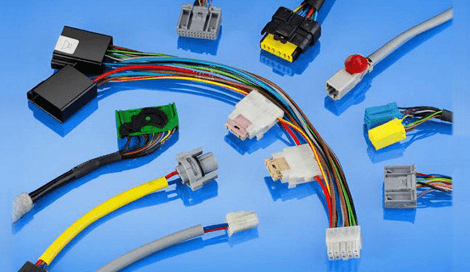As these harnesses play a critical role, you must always pick one made from high-quality materials. Further, it is equally essential for wiring harnesses to meet all sorts of safety standards. Cloom understands these facts, so we can deliver you premium quality products through a specific wiring harness manufacturing process.
Wiring Harness Manufacturing Understanding:
When the cables, wires and connectors assemble together in a complicated structure to transmit electricity and power signals, it results in a custom wiring harness or a cable assembly.
The companies involved in assembling cables and wires are wire harness manufacturers. As a part of their manufacturing, a large number of processes such as crimping, soldering, stripping and wire assembling are available at their site.
Every wire harness is assembled for a specific application using innumerable wires and connectors. However, the complexity of each harness may differ based on its use application.
Mostly, these harnesses are widely used in industrial, aerospace, automotive and other such sectors.
What does Your Contract Manufacturer (CM) Need for the Wiring Harness Manufacturing?
So, the preciseness of the information helps a contract manufacturer create a harness most appropriate to the application’s use.
* Wire lists specifying their colors, nets and connectors
* Comprehensive information regarding connectors with images showing their pin locations
* BOM with part numbers
* Assembly drawing with instructions, label locations and tolerances
* Final test specifications
Wiring Harness Manufacturing Process:
Design review:
As soon as the CM receives the design and Bill of Materials, he first reviews it to ensure everything is good to go. All the specified parts and components will be evaluated for cost, performance, and availability. In case of any issue, the CM will first look for its replacement.
Materials preparation:
Once the CM gives the green flag to the Bill of Materials, procuring materials and components starts to kick off production.
Assembly documentation:
Based on the customers’ input, the CM simultaneously starts preparing assembly documentation for manufacturing. This documentation contains strategically listed assembly steps, illustrations, images and test procedures. Along with it, technicians will also prepare an assembly panel with the pegs installed at the specified points.
Prototyping:
The working model of a wire harness design is its prototype. The manufacturers test this prototype for its use in the intended application. This prototype is inspected properly and compared with the CAD models to meet all the specifications of the drawing. Any failure means reworking the project. Ensuring the accuracy and precision at the prototype stage saves time and cost in the mass production.
Inbound inspection:
Before the wire harness assembly process, the manufacturer inspects and tests the wires, cables, and other components from the suppliers. Using a digital system to maintain data related to wire gauges, damages in connectors, correct spacing of the connectors, etc. All the information should be properly documented.
Assembly:
If the prototype passes all the parameters, it’s time to assemble the wire harness.
During assembly, a couple of quality checks and inspections are done to ensure good quality in the end products. The accuracy ensured at this stage saves time in production, builds the company’s reputation and prevents losses.
The basic process of wire assembly involves so many steps, the chances of errors also increase. Thus, each step must be carried out professionally with high precision.
* Wire stripping:To assemble wires, insulation is stripped off to reveal the central metal conductor. Care is taken to keep the wires and the insulation undamaged, as otherwise, it can lead to safety issues. It’s better to use magnification during wire stripping to ensure a smooth, clean and safe stripping process.
* Wire crimping: In case of any error, it can lead to discontinuity of the signal. Excess crimping can damage the wire, while insufficient crimping may leave the wire loose. The manufacturing team inspected the finished crimped wires through an inspection system to prevent defects.
* Wire termination: After crimping, terminal pins are attached to the wires either through soldering or by directly inserting the wire into the terminal. As the electrical devices are becoming more compact day by day, the assembly boards become further tiny. Manufacturers often use microscopes to ensure correct termination to avoid defects and damages.
Testing:
This testing phase ensures that the wire harness functions as intended. The final testing procedures include continuity tests, pull tests and megohm tests. Further, some visual testing is also done using a microscope. If any adjustments need to be made, they are done at this stage only.
After final testing, the wire harness moves to the mass production stage.
Wiring Harness Manufacturing Challenges:
To date, the process is much more efficiently done manually than by machines because of the several intricate processes in manufacturing that require manual precision.
Some of these processes are:
* Taping breakouts
* Installing cables and wires through conduits and sleeves
* Binding wires and cables with cable ties, clamps, and tape
* Installation of terminated wires in varying lengths
* Crimping wires multiple times
All these processes are still difficult to automate, and manual processing only seems to be the cost-effective solution. The time taken to manufacture wire harnesses is often more, ranging from a few days to weeks. The complexity of the designs may further extend the production times.
Manual processing does not mean that everything is done by hand. Nowadays, there are fully and half automated machines and devices for:
* Crimping one or both sides of wires
* Soldering ends of wires
* Cutting and stripping wires
* Twisting wires
* Plugging terminated wires into connector housings
Conclusion:
Cloom manufactures wiring harnesses for general applications, but there are customization options, too. For instance, we can cut, strip, twist and color the wires as you choose. We can use zip ties or cable wraps for binding harnesses, as you request. We also give you a choice of labeling services, either by heat shrink tubing or laser-printed stickers.


